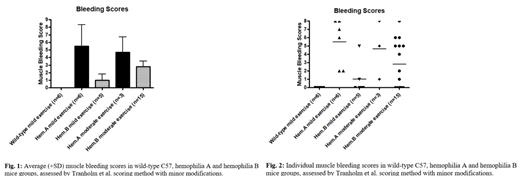Abstract
Background: Hemophilia A and B are recessive X-linked bleeding disorders characterized by the deficiency in coagulation factor VIII and factor IX. Patients with the severe form of the disease can experience bleeding into the joints and muscle either spontaneously or after provoking events including sporting injuries of different degree. Patients are prone to bleeding in the musculoskeletal system. While most research is focused on hemarthrosis, muscle hematomas are not well studied although being the second most common complication of hemophilia, accounting for 10-25% of diagnosed bleeding episodes. There is limited consensus regarding optimal diagnosis and treatment of muscle hematomas in patients with hemophilia. We are investigating the effect of physical activity on muscle and joint bleeds in mouse models of hemophilia.
Aim: The objective of this study was to compare the severity of exercise-induced skeletal bleedings in two mouse models of hemophilia A and B.
Methods: Hemophiliac F8-KO and F9-KO mice, aged from 8-12 weeks old, were subjected to either mild or moderate daily treadmill exercise for 5 days. The speed was set at 10 meters per minute for the mild intensity group and 15 meters per minute for the moderate intensity group; and the animals were exercised for 30 minutes daily. Mechanical stimulus with a brush was used to encourage the animals to run. Animals were monitored daily and on day 6 (24 hours after the treadmill exercise) the animals were sacrificed to assess bleeding events. The mice skin was carefully removed and the body was macroscopically evaluated for presence of bleeds. If muscle bleedings were present, they were assigned a score in accordance with a previously published protocol (Tranholm M et al., JTH 2015 Jan;13(1):82-91) with minor modifications.
Results: The animals were closely monitored during the study periods, and all completed the study. Normal behaviour and appearances were observed. No external bleeding was recorded. No muscle hematoma was observed in the wild-type C57-strain, thus the group received the bleeding score of 0. For the mild exercise group, the mean muscle bleeding score of F8-KO strain was 5.50 (standard error = 2.81), while the mean muscle bleeding score of F9-KO strain was 1 (standard error: 2). The two-tailed P value between the hemophilia A and B group was significant (p<0.01). For the moderate exercise group, the mean muscle bleeding score of F8-KO strain was 4.667 (standard error = 3.51), while the mean muscle bleeding score of F9-KO strain was 2.8 (standard error = 2.86). The two-tailed P value between the hemophilia A and B group was 0.33.
Discussions: The preliminary analysis of our data showed that musculoskeletal bleeding induced by exercise appears to be more severe in hemophilia A mice than hemophilia B. This is in accordance with previous observations that hemophilia B may be clinically milder than hemophilia A. In our study, there appears to be a more significant difference between the hemophilia A and B mice when the mice were subject to milder form of exercise. No statistical significance was found between the two groups when moderate exercise was given. Overall, this exercise model can be a useful tool to study the pathophysiology of musculoskeletal bleeding as well as to evaluate new therapeutic strategies in the prevention and management of muscle hematomas in hemophilia.
Gross: Leo Pharma: Honoraria; Bayer: Honoraria; BMS-Pfizer: Honoraria; Valeo: Honoraria. Matino: Bayer: Membership on an entity's Board of Directors or advisory committees, Other: research grants and personal fees; Pfizer: Membership on an entity's Board of Directors or advisory committees, Other: research grants and personal fees; Novo Nordisk: Membership on an entity's Board of Directors or advisory committees, Other: research grants and personal fees; Sanofi: Membership on an entity's Board of Directors or advisory committees, Other: research grants and personal fees; Spark: Other: research grants; Octopharma: Membership on an entity's Board of Directors or advisory committees, Other: research grants and personal fees; Sobi: Membership on an entity's Board of Directors or advisory committees, Other: personal fees.


